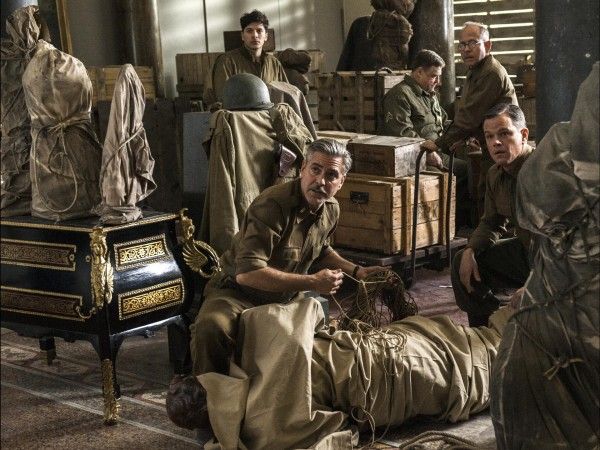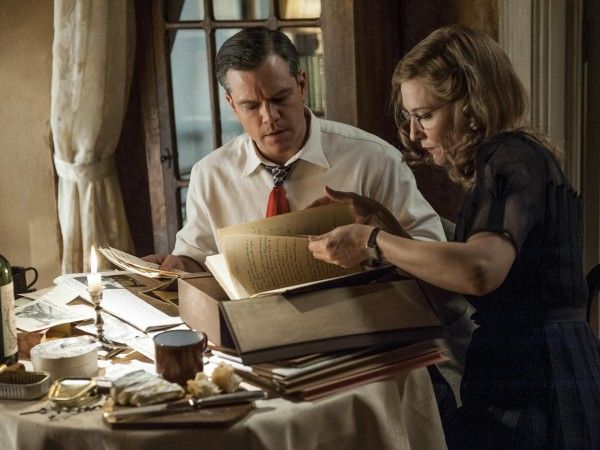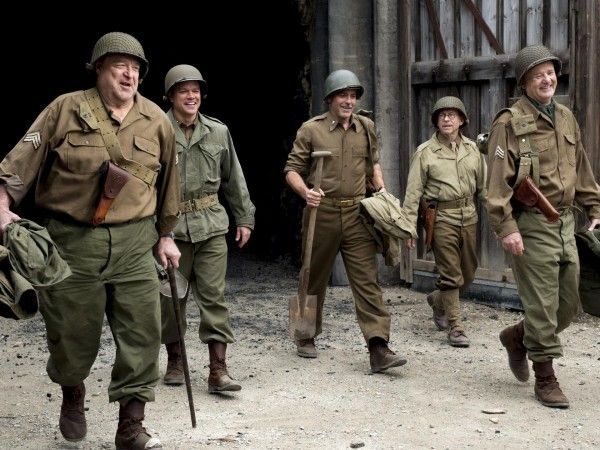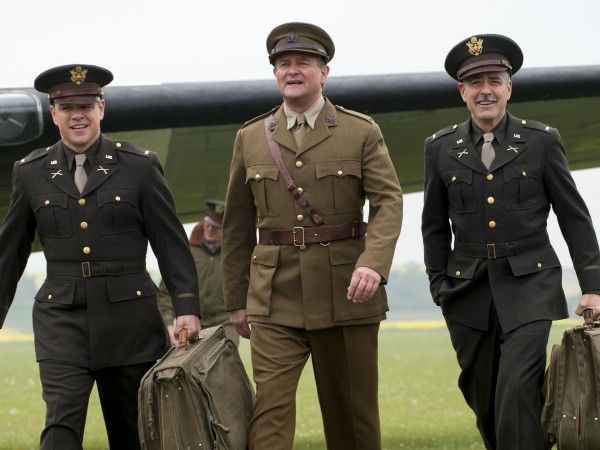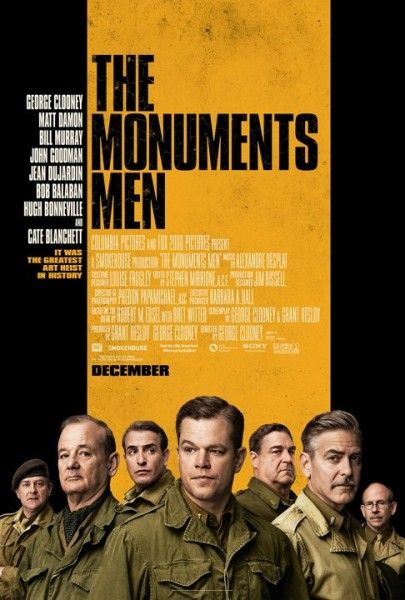Grant Heslov and his writing and producing partner, George Clooney, saw The Monuments Men as an opportunity to tell a true story with high stakes on an epic scale. Their movie about an unlikely WWII platoon that went to the front lines to rescue some of the world’s greatest art from the Nazis is not only entertaining and accessible but offers audiences a uniquely different perspective on the Second World War. Opening February 7th, the action-thriller based on the book by Robert M. Edsel with Bret Witter also stars Matt Damon, Bill Murray, John Goodman, Jean Dujardin, Bob Balaban, Hugh Bonneville and Cate Blanchett.
I recently landed an exclusive interview with Heslov who talked about the evolution of the story from book to script to screen, the reason for moving the film’s release to 2014, finding the right tone and balancing the humor with the more serious moments, what he learned by watching the film with a test audience, his collaborative process with Clooney, how writing Good Night, and Good Luck compared to this, the logistical challenges he encountered producing the film, the deleted scenes we can expect on the DVD, and his upcoming projects including what’s in active development. Hit the jump to read the interview.
QUESTION: How much change was there along the way making this film in terms of the story and the script?
GRANT HESLOV: The spirit of the story of The Monuments Men is in the film. We had to change some characters around because there were a hundred of these guys and gals. We couldn’t obviously tell the story of a hundred. The character that George is based on was the guy who spearheaded this whole thing. All these characters are either based on one particular person or a combination of characters. We had to compress. You always have to be able to compress time and move things along. If you read the book, you’ll see a lot of the film in the book. You’ll say, “There’s that moment, there’s that moment.” The book is huge. The real challenge was trying to winnow it down to a tellable story on screen.
Did a lot change from the script to what you actually put on the screen?
HESLOV: There wasn’t a lot. Not a ton of change. It was pretty faithful to the script. It’s interesting. We had to cut a couple scenes, because once you make a film, you sort of see, “Oh, we already did that moment and we kind of did it again.” You work so hard when you shoot that stuff, and when you have to cut it, it’s kind of brutal, but it was pretty faithful.
I know George likes to edit in the camera. He’s very economical in the way he shoots.
HESLOV: Yes, he’s real good that way.
Did you guys have a lot of full deleted scenes, or were there just bits and pieces cut out of the scenes?
HESLOV: Mostly bits and pieces. On the DVD, there will be a couple of scenes. There’s a big scene with Bob Balaban and Hugh Bonneville that we had to cut. It was probably the biggest action piece in the film. We ended up having to lose that. So, there were a couple big scenes and then just a lot of little nips and tucks.
From what I understand, the main reason for moving the film to 2014 was the editing process?
HESLOV: It wasn’t so much the editing process. It was that we didn’t have enough time to get all of our visual effects done. We had our cut, but then there are just a lot of visual effects in the film. We just couldn’t get them done to our satisfaction in the time that they wanted us to release.
How tough was it to find the exact tone you guys were looking for?
HESLOV: I wouldn’t say that it was tough. It was a tricky aspect that we knew all along even when we were writing it, trying to find that balance of humor balanced against what is a very serious subject knowing the kind of film that we wanted to make which was an entertaining, accessible – I think George has mentioned this – sort of a non-cynical film. The trickiest thing about the making of the film was finding the right balance of that tone.
Did you do a lot or any test screenings and what did you learn from them?
HESLOV: We just did a couple test screenings. For us, it’s not so much the feedback you get from tests. It’s not the cards and it’s not the focus groups. It’s having an audience of people who have no connection to the film. Before that, you’re screening for people that you know – friends and family and other filmmakers – and trying to get feedback. But the true test is putting it in front of an audience that has no skin in the game and to be in the room. George and I sit next to each other in these. You can just tell when you sit in an audience what’s working and what’s not working. You can tell when something doesn’t, like “Oh, this scene is too long” or “This is a funny beat” or “This is killing the joke because the audience is laughing and we’re losing the next line.” It’s really just about that.
Who were the people you invited to watch your first friends and family screening?
HESLOV: Well, a lot of friends and family. Who was there? You know I can’t even remember. There were some producer friends of ours and some writers, but it mostly was people who are either in the business or family.
I loved Good Night, and Good Luck. I’m wondering how tough was that script to write and how much changed from inception to the final product?
HESLOV: That script was not hard to write. That script came to us pretty quickly. We wrote it in four weeks or something like that. We changed very little from the script. I think maybe five percent we changed. I mean, it was very little compared to what we normally have to do.
When you were working with George on this film, how did the two of you collaborate on the script? What’s your working process?
HESLOV: We have an office. We sit in the office. I write on a computer and he writes longhand. We usually break the story first. For instance, on The Monuments Men, and this one is more complicated because there’s a lot of history, so before we started, we sat down with Robert Edsel, the author of the book, for about a week, and basically, he just gave us a lecture and went through everything. And then, I had a researcher, somebody who we had actually used on Argo. Our whole office was covered with boards, characters, pictures, photos, timelines and everything. It was pretty amazing. And then, we used 3 X 5 cards and we just started talking about scenes. We put them up on the wall and we moved them around, and when we’d finally get it where we wanted it, then we’d start to write. Sometimes we’ll write them separately. We’re always in the same rooms. Sometimes we’ll be working on different things and I’ll get it all into the computer, and then often what we do is we read the scenes out loud. We actually perform them just to see how they feel. And that’s it.
How long did it take to write this in comparison to Good Night, and Good Luck?
HESLOV: This took longer. For this, we probably did a couple months of just research and getting to know the subject. And then it probably took another three to four months to get to the draft that we ended up giving to the studio.
Did you have an opportunity to talk to any of the people who are still alive that were associated with The Monuments Men?
HESLOV: Not really. There is only one person that I know who’s is alive that is compos mentis so to speak and that’s Harry Ettlinger. We corresponded but we didn’t speak to him. As I said before, we spoke with Robert Edsel who wrote the book and he’s the reigning expert on this. I would call him and say, “Is this…?” We would send him the script and get his feedback.
Every project has different challenges. What were the unique challenges of this film for you from a producing standpoint?
HESLOV: Logistically, it was a big picture. With World War II, it was just getting the proper equipment and vehicles and tanks. There’s not a ton of that stuff around. So that was tricky. We shot all over Germany and we shot in the U.K. There were a lot of moving parts. When you look at a film like The Ides of March or Good Night, and Good Luck even, those are really contained pictures. With this, the real challenge was trying to find the locations that we could augment and have them feel real and of the period. That was tricky. And then, there were a lot of visual effects. That’s always a challenge. As a producer, there’s a lot to juggle there as well.
Looking back, is there anything you wish you’d known when you first started filming?
HESLOV: I wish I’d known how cold it was going to be in Berlin. It was freezing. It was the coldest winter on record. I don’t know if I could have changed anything, but I would have been more prepared. It was really, really cold. We did have to move things around because the weather was so cold and we needed particular stuff. For instance, the Battle of the Bulge scene where there’s all the snow on the ground, we weren’t planning to shoot that day and then all of a sudden there was a huge snow storm. George and I were like, “We’ve got to go shoot the Battle of the Bulge scene.” We were going to make snow. We were going to do all this stuff and here it was. So we switched the schedule. We got everybody and we went and shot it that day.
How does the final film compare to what you originally envisioned?
HESLOV: It’s better than I envisioned. I’m really proud of it. When you’re writing and conceiving a film, you have an idea in your mind of what it’s going to be and this surpasses the idea.
What did you learn about yourself as a filmmaker in the process of making this film?
HESLOV: On a film like this I learned to appreciate my home and my wife and my kids because I was away so long. That actually is the hardest thing about making films when you have to be away from your family for a length of time. I relearned. I’ve learned this before, but you sort of forget about how important your family is when you’re away for six months.
You’ve been linked to a number of upcoming projects. What is on your calendar to do right now and what’s in active development?
HESLOV: That’s a good question. There are a couple things brewing. I don’t want to talk about them. I’m very superstitious. We don’t develop a lot of material. We develop usually anywhere between five and ten things and we really focus on them. We make a very high percentage of what we develop because we’re pretty picky. But there’s a couple. There is one thing that I think is imminent, and hopefully if all goes well, we’ll be shooting it this summer. (Laughs) Is that a good evasive answer?

